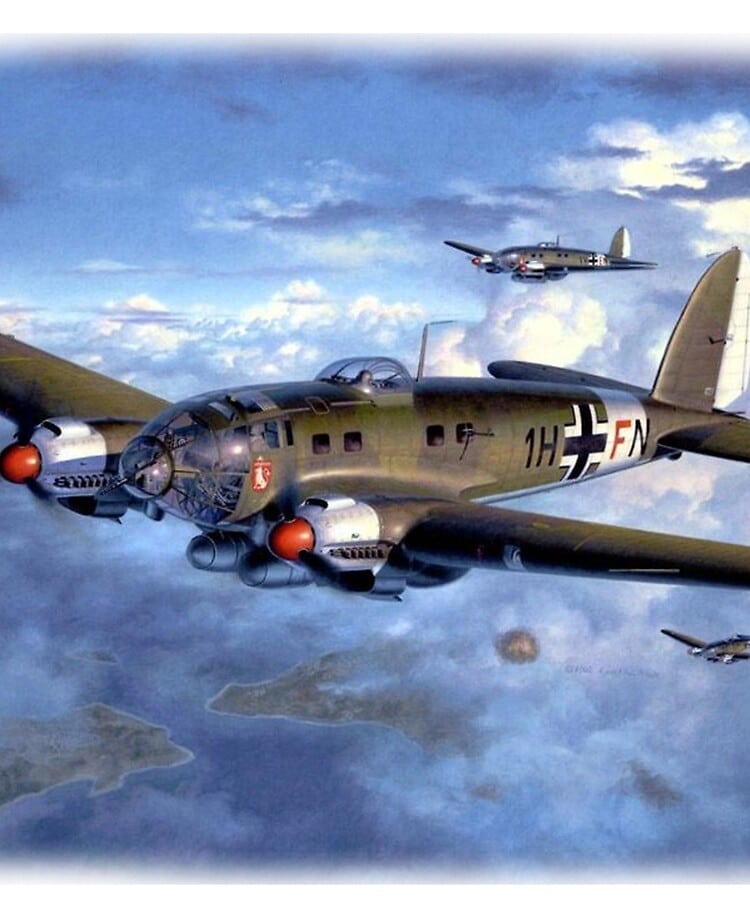After its defeat in World War I, Germany was banned from operating an air force by the Treaty of Versailles. Following Hitler’s ascent to power, German re-armament began in earnest in the early 1930s although this was initially kept secret because it clearly violated the treaty and the early development of military bombers was disguised as a development program for civilian transport aircraft.
Among the designers seeking to benefit from German re-armament was Ernst Heinkel and entrusting development to two fairly new and untested designers to the company, he decided to create the world’s fastest passenger aircraft, a goal met with scepticism by Germany’s aircraft industry and political leadership.
This ultimately delivered what became the Heinkel He 111 designed by Siegfried and Walter Günter at Heinkel Flugzeugwerke in 1934. Throughout its development it was described as a “wolf in sheep’s clothing”. Due to restrictions placed on Germany after the First World War prohibiting bombers, it maintained the charade and masqueraded as a civil airliner, although from conception the design was intended to provide the nascent Luftwaffe with a fast medium bomber.
Features of the He 111 were apparent in the Heinkel He 70. The first single-engined He 70 Blitz (“Lightning”) rolled off the line in 1932 and immediately started breaking records. In the normal four-passenger version its speed reached 380 km/h (230 mph) when powered by a 447 kW (600 hp) BMW VI engine. The He 70 was designed with an elliptical wing, which the Günther brothers had already incorporated into the Bäumer Sausewind before they joined Heinkel. This wing design became a feature in this and many subsequent designs they developed. The He 70 drew the interest of the Luftwaffe, which was looking for an aircraft with both bomber and transport capabilities.
The He 111 was a twin-engine version of the Blitz, preserving the elliptical inverted gull wing, small rounded control surfaces and BMW engines, so that the new design was often called the Doppel-Blitz (“Double Lightning”). When the Dornier Do 17 displaced the He 70, Heinkel needed a twin-engine design to match its competitors. Heinkel spent 200,000-man hours designing the He 111. The fuselage length was extended to just over 17.4 m/57 ft (from 11.7 m/38 ft 4½ in) and wingspan to 22.6 m/74 ft (from 14.6 m/48 ft).
Perhaps the best-recognised German bomber due to its distinctive, extensively glazed “greenhouse” nose of later versions, the Heinkel He 111 was the most numerous Luftwaffe bomber during the early stages of World War II. The bomber fared well until the Battle of Britain, when its weak defensive armament was exposed. Nevertheless, it proved capable of sustaining heavy damage and remaining airborne. As the war progressed, the He 111 was used in a variety of roles on every front in the European theatre. It was used as a strategic bomber during the Battle of Britain, a torpedo bomber in the Atlantic and Arctic, and a medium bomber and a transport aircraft on the Western, Eastern, Mediterranean, Middle Eastern, and North African theatres.
The He 111 was constantly upgraded and modified throughout its life, but became obsolete during the latter part of the war although the German “Bomber B” project was never realised, which forced the Luftwaffe to continue operating the He 111 in combat roles until the end of the war. Manufacture of the He 111 ceased in September 1944, at which point piston-engine bomber production was largely halted in favour of fighter aircraft. With the German bomber force virtually defunct, the He 111 was used for logistics.
Production of the Heinkel continued after the war as the Spanish-built CASA 2.111. Spain received a batch of He 111H-16s in 1943 along with an agreement to licence-build Spanish versions. Its airframe was produced in Spain under licence by Construcciones Aeronáuticas SA. The design differed significantly in its power-plant configuration however, eventually and perhaps ironically being equipped with Rolls-Royce Merlin engines. The Heinkel’s descendant continued in service until 1973.
